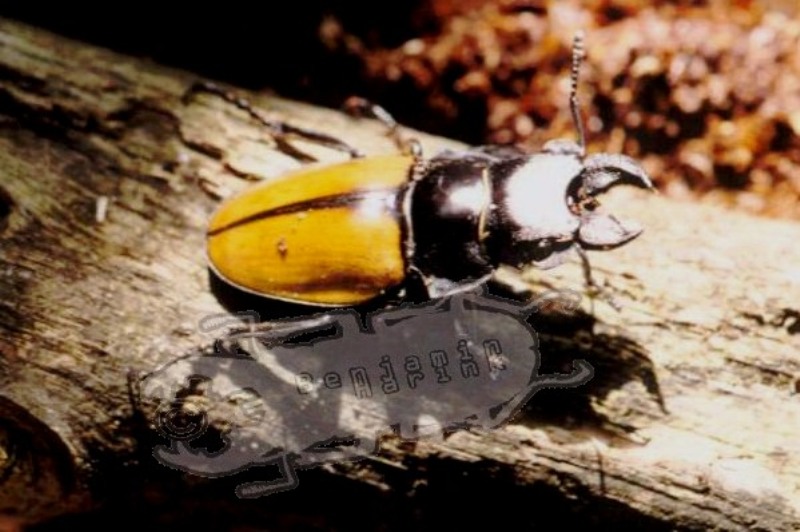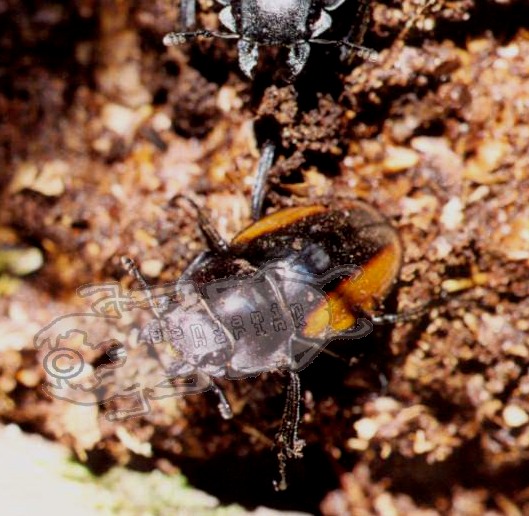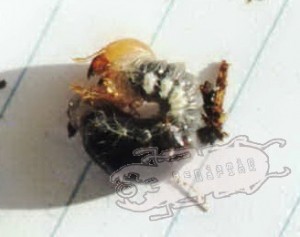This report about my experiences with Odontolabis gazella is based on data I collected from 1999 until now. I got two males and 4 females on the 12.06.99. They had been caught in the Cameron Highlands in Malaysia. The males were about 65 mm in size and the females about 40 mm. I divided them into two groups, each containing 1 male and two females.
They were put into two containers ( 20 x 30 x 60 , L x B x H ) that had been filled with a mixture of rotten leaves, potting soil and rotten soft oak wood in a relation of 1 : 1 : 3. The height of substrate was about 15 cm. I kept the substrate slightly wet and kept the containers dark. I fed the imagines with fruit jelly or banana juice, that was accepted very well.
On the 29.06.99 I found the first eggs. I observed the first larvae on the 08.07.99. From now on new eggs were laid continuously and a lot of larvae were hatching out. At total I recorded about 150 larvae. I separated the larvae in small containers, like photo boxes or jelly jars. I tried feeding them different mixtures of compound, for example soft oak wood only, or the mixture the eggs had been laid into and earth like rotten oak wood. I found out that the oak wood only mixture was not accepted by the larvae and thus led to their death. The other mixtures led to an continuous growing. Despite of this, I had a high die- off rate in the first larval stage. It was striking that the larvae in bigger containers were growing a lot faster than those in smaller photo boxes. After having made that experience I put the rest of my larvae in 1 litre containers. They were fed with the earth like rotten oak wood and were now growing fast and continuously.
It was interesting to see, that the larvae were building caves, the walls of which they made out of their feces. 5 larvae, that were kept together in a 5 litre container did the same, without disturbing each other. I was not able to observe any cannibalism, but I would strongly recommend keeping the larvae separated. On the 04.12.1999 the larvae weighed about 9 grams and 14 grams the 18.01.2000. I recorded the first cocoon the 25.02.2000. It was about the size of an chicken’s egg and the walls were about 1 cm thick. The cocoons were build in the middle of the container without using it’s walls. It was striking, that the larvae stayed quite long in the prepupa stage ( about 6 weeks) until they moulded to the pupa stage. The first female of the F1 generation hatched out the 10.06.2000.
Larval Head Sizes(taken from larvae of the second generation):
- L1: 2mm x 2mm (head width x head height)
- L2: 4-4.5mm x 5mm(head width x head height)
- L3: 10-11mm x 13mm (head width x head height)
As I had forgotten to feed them sometime in their second larval stage, they didn’t reach the sizes of their parents. The females were about 3,5 cm in size and the males about 4,5. Nevertheless, soon they were mating and now the second generation is in the beginning of the 3rd stage. I was able to observe that the die off rate of the L1 larvae is decreasing, if they are not disturbed and put in different containers. I would recommend to wait until they reached the second stage and then separate them .
It is striking, too, that Odontolabis gazella larvae also feed on rotten leaves and grow quite well, if only a little wood is mixed in. If only feed on wood, they need extremely rotten wood, that is almost like potting soil, as harder wood easily kills them. Females posit their eggs, like many cetonids simply in the soil. I would recommend Odontolabis gazella, because of the great number of eggs laid and the relatively easy growing larvae, as a pet for beginning stag beetle breeders.
Supplement added in September: Right now I have a big number of larvae and eggs of the 3rd generation. Eggs have been laid into a mat that contains wood and leaves in the same amount.
Conclusions: I have bred this species until the beginning of 2003 and given it off to other breeders after that. I believe it was lost in breedings shortly after that. Recently I have seen larvae from Indonesian origin offered. A very interesting aberration which happened in F4 was that some males developed an elytrae pattern similar to females, in a way that they had a thicker black band in the middle of the elytrae.Sadly that strain was lost and I only kept one specimen at that time, not thinking it was something interesting. Aah, well… Another advantage of O. gazella is that there are normally no telodont males, so breeding for beginners is not as frustrating as breeding other telodont species and ending with amphiodont males in the following generations. I have seen pictures of supposedly telodont O. gazella, if they are true they still are very rare, even in the wild.




also i want to learn some few techniques of collection from you.